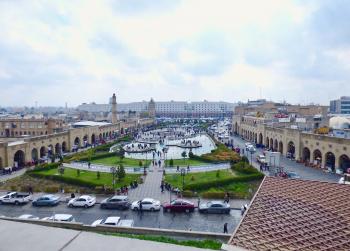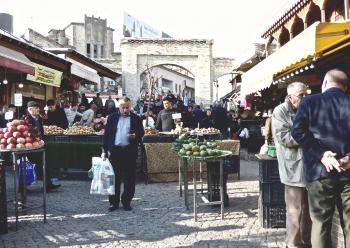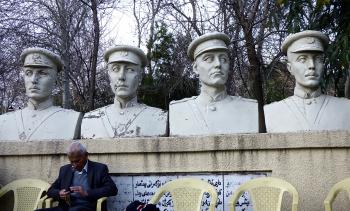Finding beauty in Iraqi Kurdistan
This article appears on page 20 of the January 2020 issue.
My dream came true. Finally, after 62 years of travel, my intense desire to close a large, gaping hole in my travel map of the Middle East was fulfilled.
MT Sobek (Emeryville, CA; 888/831-7526, mtsobek.com) put on a superb 9-day exploratory tour of Iraqi Kurdistan departing March 6, 2019. The tour cost $5,095, with a $715 single supplement. And what a tour it was!
Erbil
The sheer beauty of Iraqi Kurdistan absolutely shocked me. Mountains unexpectedly surrounded us everywhere we went, and there was snow in those mountains! The snowcapped scenery certainly enhanced our photographic opportunities.
Our guide, Balin Zrar, an affable, incredibly resourceful young man from Iraq, had a marvelous command of the English language, having lived in England for four years. He made life easy for the group at every turn, even sending us into a little shop along the way to pick out any treats that we might want for the trip. Then he paid the entire bill!
We started our first day in Erbil, the capital city of Iraqi Kurdistan, at the Erbil Civilization Museum, which houses artifacts dating back to 5000 BC. In addition to the antiquities, we encountered our first group of really enthusiastic schoolchildren, who were absolutely delighted to meet and photograph us with their cell phones as they followed us through the exhibits.
Our tour then took off up a rather high hill for a visit to the 7,000-year-old Citadel of Erbil. This immense, imposing, fort-like structure is actually a tell (an archaeological settlement mound) standing on flat terrain. Façades of about 100 houses built in the late 19th century hide the tell, making it look like a fort from the outside.
UNESCO dates the site back to the Assyrian settlement of Arbela, with even earlier settlements possible. It houses a hammam (bath) built in 1775 plus the rebuilt Mulla Afandi Mosque, a textile museum, markets and an entire medley of people wanting to take selfies with us. I could hear the children giggling behind me as they tried to get in place for a photo, and several women kissed me on the cheek. Perhaps it was my age, but they made me feel amazing and welcome.
Markets and meals
It was time to hit the Qaysari bazaar across the street, which revealed gold markets, alive and thriving; rugs of vast numbers of patterns, age and quality, ready and waiting to be sold, and a few souvenir trinkets and sweets to dazzle my eyes. My favorites included vintage Bedouin jewelry that would have been worn by women out in the desert sands of the Silk Road. Those pieces made me feel like I was with those ladies as they traversed many fabulous countries.
The colorful outdoor markets had huge varieties of fresh fruit and vegetables, along with clothing, toiletries, toys, pots and pans…. I think you get the idea.
This is where you can buy almost everything — except there’s no McDonald’s. Imagine, instead, delicious lentil soup followed by mezze plates of fresh tomatoes, cucumbers, eggplant salad, olives, hummus and tabouli salad, all accompanied by fresh, warm, right-out-the-oven Kurdish bread the size of a pizza. And that’s just for starters!
Next comes a meat dish, perhaps shish kebab — chicken, beef or lamb — or chicken tikka. Or maybe you prefer vegetable-stuffed dolmas? These choices were available every single lunch and dinner. It was all very tasty, and MT Sobek allowed us to order whatever we wanted throughout the tour.
Into the mountains
Then it was time to venture beyond Erbil. Most of the roads we traveled on were excellent, lined with military-themed artwork and statues of freedom fighters called Peshmerga. There was an occasional military or traffic-police checkpoint.
Our bus was roomy, allowing each of us to have a window seat. Along our drive, we visited the site of the battle of Gaugamela, where Alexander the Great defeated King Darius III’s forces. It was awesome to stand on ground where Alexander the Great once stood.
One morning, Balin happily announced that it was a Kurdish holiday called “Dress-up Day” (known as Nawroz). The Kurds would be outfitted in their finery, which meant to the teenaged girls diaphanous dresses and 6-inch-high heels! What a fine day to visit the Mullah Mustafa Memorial and the cobblestoned fortress city of Amadiya.
Moving right along, we visited Alqosh, where the tomb of the prophet Nahum, whose claim to fame was his prediction of the fall of Ninevah in 612 BC, is said to be located within the ruins of an 800-year-old synagogue. We also visited St. Matthew’s Monastery, carved into the rock of Mount Maqloub in about 363. It was incredible to imagine how carvers were able to create something so elegant while hanging off the side of a mountain.
As we continued up into the mountains, the snow caused a few issues logistically. We were unable to traverse the mountainous roads up to the palace of Saddam Hussein, which I really wanted to see, but we did successfully make it up a very curvy, narrow road to our hotel, located high up on Mount Korek. There was a gondola lift available, but it was not in service as we entered the area. (It did work the following day.)
The Korek Mountain Resort & Spa offered hiking, massages, gondola rides and car service around the grounds and had a host of lively colored street-art animals around the property just for fun.
Somber sites
There were two extremely somber venues included in our itinerary. First, it must be remembered that the Kurdish people living in Iraq had been targeted by Saddam Hussein, who attempted to rid Iraq of the Kurdish people through genocide. The Red House, a former prison in Sulaymaniya, documents the horrors the Kurds endured. Shards of glass in the Hall of Mirrors represent the more-than-180,000 Kurds who “disappeared.” The museum has vast amounts of information and exhibits presented in excellent displays.
The other venue, the Halabja Monument & Museum, along with the Martyrs’ Monument & Cemetery, also in Sulaymaniya, documented the massacre and horrors of Saddam Hussein’s chemical weapons attack on Kurdish villages in 1988; 3,000 to 5,000 people died and 7,000 to 10,000 were injured. This venue — with its excellent museum exhibits, Halabja Monument, Martyrs’ Monument and outdoor statues, along with the cemetery — provided very powerful imagery recounting those tragedies.
Visiting the Yazidis
The true highlight of this tour was my visit to Lalish, the pilgrimage site of the Yazidi (aka Yezidi) people. I found the Yazidis to be friendly, welcoming people.
Visitors must remove their shoes to enter the sacred village, so Balin provided socks for everyone to wear. He also aided anyone who experienced difficulty walking in their stocking feet on the cobblestones to ensure that everyone was able to visit the temple.
Note: Do take a flashlight, as there were no lights in the temple.
We were cautioned to step over the thresholds of the doors, as the Yazidis believe that there are angels at each doorway.
Each devotee of the Yazidi religion is supposed to make a pilgrimage to the temple for six days during their lifetime to visit the tomb of Sheikh Adî and other sacred objects housed there.
The Yazidis are intent on keeping the temple and grounds meticulously clean, and during my visit they energetically swept all areas with large, short-handled whisk-type brooms.
The Yazidis have been in world news lately. Five years prior to my visit, members of ISIS captured thousands of young Yazidi women and children in northern Iraq. The women went through a horrific time as the ISIS captors tortured, raped and impregnated them.
Throughout our tour, I saw many troubling pictures of shrouded young girls with their heads bowed in shame for having had unmarried sex outside of the Yazidi faith. They each wore a white scarf, the traditional Yazidi head covering, which hid their identities. The portraits are displayed as a tribute to these women.
MT Sobek put on a wonderful tour, and I wanted to share my experience so that other people could learn about this beautiful country and its people. Iraqi Kurdistan is open for tourism. F
Editor’s note: While there are personal accounts online from many travelers and tour operators that suggest travel to Iraqi Kurdistan, in northern Iraq, is safe relative to other areas of the country, it must be noted that the US State Department does not make a distinction between this area and the rest of Iraq. Currently, travel.state.gov lists a “Level 4: Do not travel” advisory for Iraq due to terrorism, kidnapping and armed conflict.




